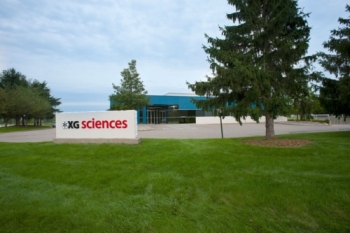XG Sciences, Inc. (XGS) announced today that it has launched a new generation of anode materials for lithium-ion batteries (LIB) with four times the capacity of conventional anodes.
 XG Sciences' Headquarters and 40,000-square-foot manufacturing facility located in Lansing, MI. (PRNewsFoto/XG Sciences)
XG Sciences' Headquarters and 40,000-square-foot manufacturing facility located in Lansing, MI. (PRNewsFoto/XG Sciences)
The new anode material is produced through proprietary manufacturing processes and uses the Company's xGnP® graphene nanoplatelets to stabilize silicon particles in a nano-engineered composite structure. The material displays dramatically improved charge storage capacity with good cycle life and high efficiencies.
Available Immediately at Commercial Scale
"We are pleased to announce the immediate availability of this new high-capacity anode product," said Rob Privette , VP Energy Markets. "Our new Silicon-graphene anode material, when used in combination with our existing xGnP® graphene products as conductive additives, provides significantly higher energy storage than conventional battery materials. This is great news for applications like smartphones, tablet computers, stationary power and vehicle electrification that use rechargeable lithium-ion batteries. We are working with battery makers to translate this exciting new material into batteries with longer run-time, faster charging and smaller sizes than today's batteries."
Mr. Privette said that the exact performance of the new anode materials will depend on the specific battery formulations used by the cell manufacturer, noting that XGS has demonstrated capacity of 1500 mAh/g with low irreversible capacity loss and stable cycling performance in life tests. "One of the key focus areas of our research team was to produce a material that can be inserted relatively easily into the complex battery production processes that are used today. Our goal was to minimize the need for major changes to electrode coating processes or assembly techniques," he added.
"We expect initial adoption in the highly-competitive consumer electronics markets that are dominated by Asian battery makers," Mr. Privette said, "but we also have research and development partners that are focused on hybrid and electric vehicles, grid storage, military, and specialty industrial applications. Over time, we anticipate formulating custom nano-engineered anode materials with specific properties for each of these major markets."
Competitive Prices
Mike Knox , the XGS CEO, said that "in keeping with our focus on developing cutting-edge science for commercial applications, we engineered the nano-materials and processes to produce anode materials that are available today at commercially attractive prices."
"As the world's largest producer of graphene nanoplatelets, we have the capacity and production expertise to produce battery materials efficiently and effectively, and we have global production partners. For example, two of our strategic partners, POSCO and Hanwha Chemical, already manufacture electrode materials for lithium-ion batteries. One of our licensees, Cabot Corporation, recently introduced their first battery additive based on our technology. We are also proud to work with such diverse development partners such as Georgia Tech, several large battery manufacturers, and several of the US National Laboratories."
Mr. Knox added that he wanted to thank the U.S. Department of Energy for supporting the Company's ongoing development of anode materials for extended range electric vehicles.